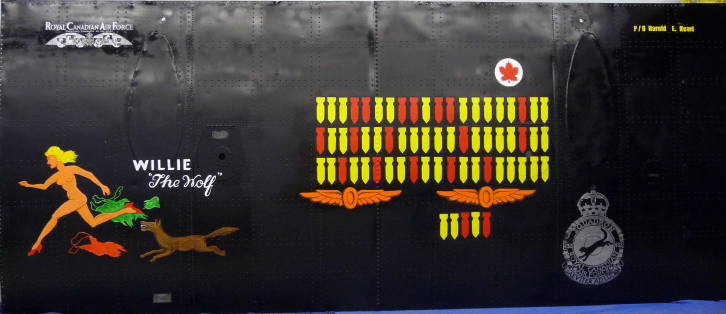 Nose Art
Nose Art  |
BCATP
|
Lancaster
|
Media
|
BCATP
|
Lancaster
|
Media
 Nose Art
Nose Art  |
BCATP
|
Lancaster
|
Media
|
BCATP
|
Lancaster
|
Media
Museum Collections
Clarence Simonsen Nose Art Collection
Nose Art
S/L Donald Patterson, "B" Flight Commander with No. 426 Squadron, selected Halifax LW-207 as his aircraft and flew the aircraft on sixteen operations. It was assigned the markings "OW-W" and named "Willie The Wolf From The West". The name was taken from the 1943 movie "Riding High" that starred Dorothy Lamour and featured a song titled, "Willie the Wolf of the West". S/L Patterson appears to have modified the title by substituting "from" for "of" as he was "from" the west -Calgary, Alberta. The artist definitely had Donald Patterson in mind when he did the painting because the wolf is wearing a squadron leader's tunic. Both "Willie the Wolf From The West" and "Ol Daid Eye" are among fourteen panels of Halifax nose art that were cut from RCAF aircraft that were about to be scrapped following the war. They are currently on display at the Canadian War Museum in Ottawa. |
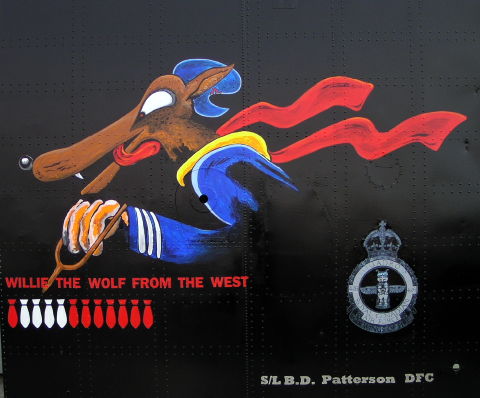
|
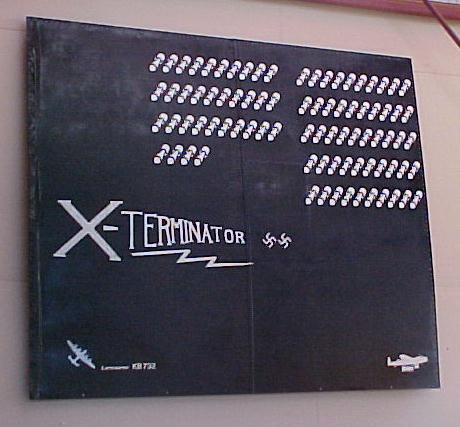
|
419 Squadron KB732 was referred to as X-Terminator. It completed 84 operations against the enemy, more than any other Canadian-built Lancaster and its air-gunners shot down two enemy fighters. This full scale replica of the nose art from X-Terminator was painted for the Society by Clarence Simonsen. The painting has been done on a wing panel from Lancaster FM107 that was flown Canada to Britain during 1945 but arrived too late to be assigned to a squadron and participate in the war. |
The nose art that has been painted on the museum's Lancaster cockpit section replica duplicates that of Lancaster KB-864 of No. 428 Squadron RCAF. The figure is based on the popular "Varga" pin-up girl who was featured in the January 1945 edition of Esquire magazine. The aircraft's markings were NA-S and the aircraft would have been referred to as "S for Sugar." Sugar's Blues was a popular wartime dance tune. Each of the diving figures represents a successful operation. The art work on KB-864 was painted by Wireless/Air-gunner Sgt. Tommy Walton. Mr. Walton is now a member of the Nanton Lancaster Society. The replica on the museum's mock-up is the work of Clarence Simonsen. |
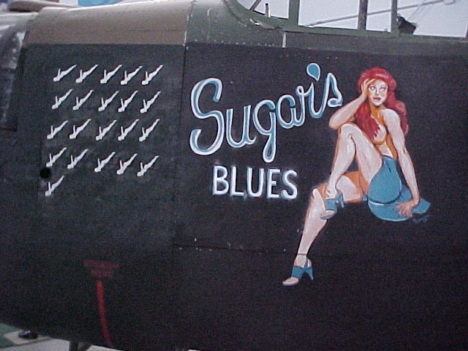
|
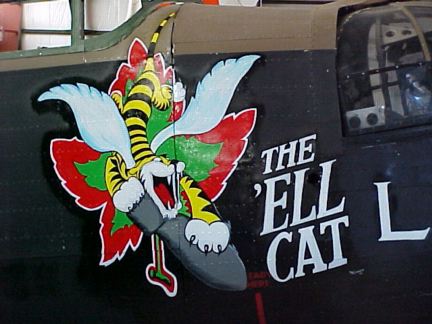
|
This nose art has been painted on the starboard side of the museum's Lancaster cockpit section replica by Clarence Simonsen. The original work was done in 1945 on No. 424 (Tiger) Squadron Lancaster QB-L (NG484) by Matthew Ferguson of Calgary, Alberta. |
A close examination of this artwork will reveal much about Joe McCarthy, an American who served with the Royal Canadian Air Force. Note the Union Jack, American flag, Canadian maple leafs, Churchill cigar, Roosevelt cigarette holder, the Dams Raid, a Tallboy Bomb, a No. 617 Squadron crest, a painting of Joe, and in all of the images, a big friendly panda bear. The artwork is painted on a Lancaster wing panel. |
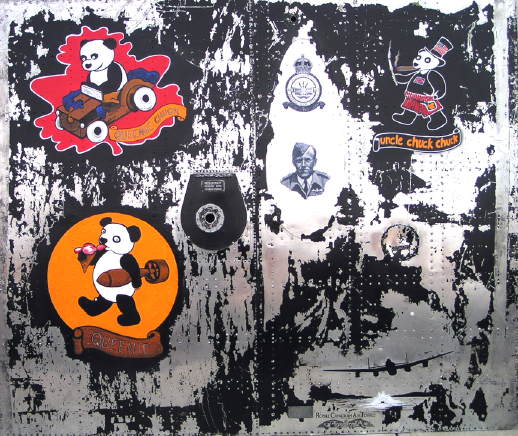
|
R���obert Kerns was born in Acme, Alberta, in 1912 and enlisted in the RCAF in 1942. As the navigator on F/Sgt James Dunlop's crew, he was posted to No. 166 Squadron in April, 1944. After completing six operations, the crew was assigned a brand new Lancaster (LM550) with the markings AS-B. The Canadian pilot and crew loved their beer, and the call sign became "B for Beer." The crew also adopted the Arthur Lloyd song titled - "Drink, And Let's Have Another." They arranged for a ground crew artist to paint the artwork on their new aircraft. For the next 21 operations the Dunlop crew safely flew "Let's Have Another." For each operation a small beer mug was painted beside the barrel.
In October 1944, Lancaster LM550 was transferred to No. 153 Squadron where she finished the war with a total of 118 beer mugs on her nose. Robert Kerns was present at the Nanton Lancaster Air Museum when Clarence Simonsen's artwork was unveiled in 2003. It was painted on a Lancaster wing panel.
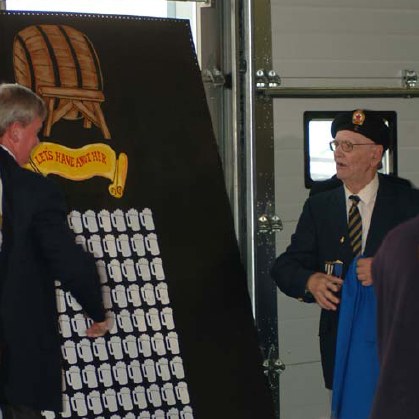 the unveiling of the nose art replica in 2003. |
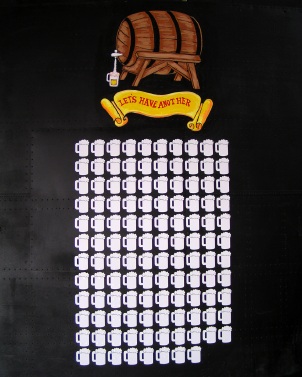
|
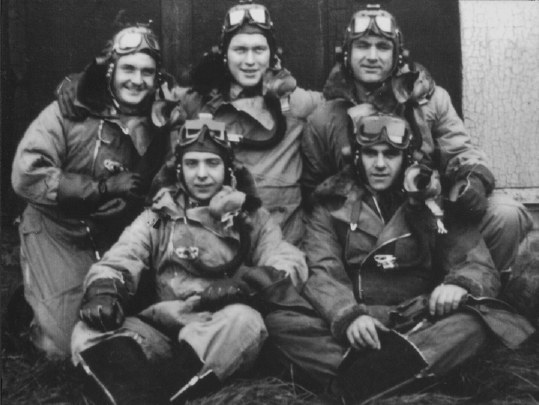
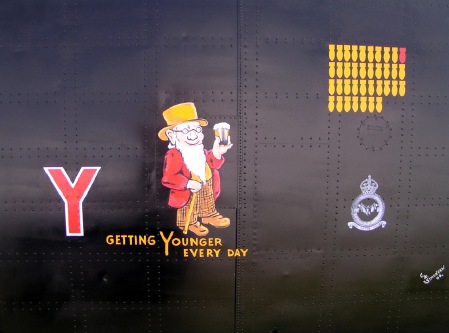
|
No. 9 Squadron Lancaster "WS-Y" carried this nose art on November 12, 1944 when P/O Doug Tweddle flew the aircraft on the raid that sunk the Battleship Tirpitz. His daughter, Maggie Tweddle of St. Albert, Alberta and son John Tweddle of England, unveiled this replica nose art on July 31, 2004. It was painted on a Lancaster wing panel by Clarence Simonsen. The figure in the artwork was the symbol of a type of beer favoured by P/O Tweddle and his crew. According to his son, they "borrowed" a tray that featured the artwork from their favourite pub and asked a talented member of their ground crew to paint this nose art on their aircraft. |
|
"Johnnie Walker" was painted on Lancaster W-4964, WS-J of No. 9 Squadron, Royal Air Force. The aircraft had a distinguished career, logging a total of 106 operations. Likely the most detailed piece of work of the war, it features the Johnnie Walker whiskey symbol with the firm's equally famous motto, "Still Going Strong." The artwork includes the ribbons from four DFM's and two DFCs that were awarded to her aircrew. The chevron indicates a year's service on active duty. Below are three wound stripes, one for a container of fifty, four pound incendiary bombs that were dropped from above and passed through the aircraft's wing. Below these is the ribbon for the 1939-1945 star medal followed by a swastika indicating an enemy fighter shot down and a marking for a searchlight that was shot out at low level. The bomb tally indicates 104 regular night operations, one day operation, and a larger bomb indicating the 12,000 pound "Tall Boy" bomb dropped by J-Johnnie that struck the Battleship Tirpitz on the aircraft's 100th operation. The red star recalls the aircraft's visit to Russia en-route to bombing the Tirpitz. This replica of the nose art from "Johnnie Walker" was painted by Clarence Simonsen on a wing panel from a Canadian-built Lancaster. |
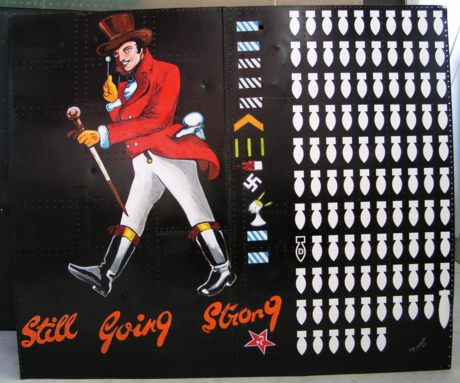
|
Bomber Command Mosquito LR-503 flew more operations than any other World War II Bomber. The aircraft first served with No. 109 Squadron RAF and later with No. 105 Squadron where it carried the markings GB-F and became known as "F for Freddie." It carried nose art that featured a mosquito dropping a bomb on Hitler. The bomber completed a total of 213 operations but then tragically crashed in Calgary, Alberta two days after the war in Europe ended. F for Freddie had been touring Canada as part of a Victory War Bond Drive. The Mosquito was a wooden airplane, covered by thin plywood. This full-size, replica of F for Freddie's nose art was painted by Clarence Simonsen on WW II aircraft plywood moulded into the shape of a Mosquito's nose. The plywood was originally part of a Hadrian Glider. |
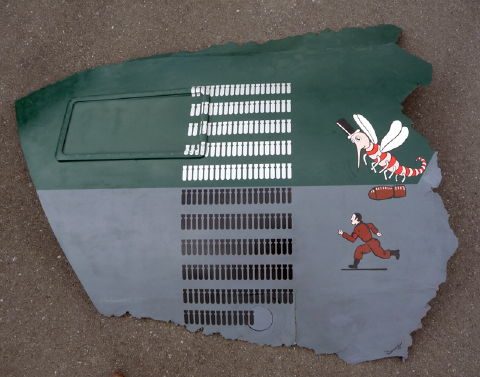
|
Known as 'M for Mother', Halifax LV993 completed a total of ninety-six operations with 429 Squadron RCAF between 22 April, 1944 and 15 March, 1945 -the most operations flown by an RCAF bomber during the Second World War. Her impressive bomb-tally was carefully recorded by LAC A.C. Robinson and possibly others.

|
The white bombs in the tally indicate night raids, the outline-only bombs indicate daylight raids. The three that show a large cylinder suspended by a parachute indicate a 'gardening' or mining operation. The DFC above the bomb tally represents that of S/L Neilly of Gilford, Ontario who completed two tours of operations, the first with 429 Squadron RCAF and the second with 405, the Canadian Pathfinder Squadron. S/L Neilly flew sixteen operations as LV993's pilot. The DFC citation refers to one of F/Lt Neilly's operations when, "An engine failed shortly after takeoff, but he continued and successfully completed his mission. On the return journey, another aircraft was seen to fall into the sea. |
RCAF Halifax JD372 was flown by 429 Squadron RCAF. The aircraft's nose art, 'Easy Does It!', featured a 'Gremlin' riding a huge bomb which is going to destroy Nazis. The aircraft's markings were 'AL-E'.
|
On 22/23 November 1943, JD372 was struck by flak, developed engine trouble, and returned to base. During the repairs, it is thought that the nose was re-painted black and the original Gremlin nose art covered over. The unknown nose artist then repainted the nose art with name 'Easy Does It Too!' There is an interesting connection of this nose art to 'gremlins', a wartime Hurricane fighter pilot who became a well-known author of children's literature, Walt Disney, and James Bond. 'The Gremlins' is a book written by RAF fighter pilot Roald Dahl and published in 1943. It was Dahl's first book and was written for Walt Disney Productions in anticipation of a feature-length, animated film that was never made. As part of the story, Dahl created a series of characters called 'Gremlins'. |
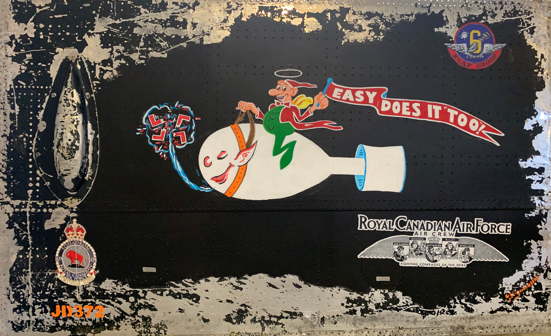
|
Ron Jenkins father was a pioneer in the grocery business in Calgary and Ron was involved in the family business both before and following his wartime service as a bomber pilot. Canadian built Lancaster KB-895 become his personal aircraft with code "WL-O." The crew decided that "their" bomber needed a name and nose art painting. At first they named her "Wee Lady Orchid" for each of the code letters. Later they dropped the "Wee" and she became "Lady Orchid." The painting of the Lady Godiva pin-up riding a bomb included two western style six shooters to reflect Jenkins' Calgary connection. F/O Jenkins flew a total of fifteen operations, five in Lady Orchid. Under his pilot's position he painted fifteen white bombs and one red bomb for an aborted operation.
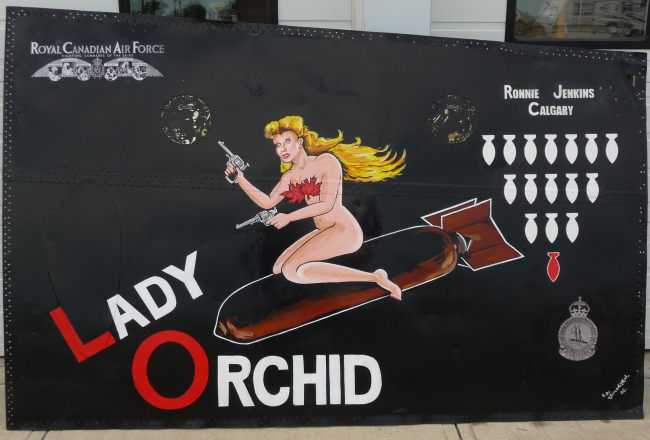
Nose artist Thomas Dunn was from Winnipeg, Manitoba. He had drawing talent but had received no training until high school where he enrolled in hand lettering. Dunn was an RCAF airframe mechanic at East Moor, Yorkshire where No. 432 Squadron was based. He began painting nose art in the spring of 1944 and "Willie the Wolf" was the eighth Halifax to cary his work. It was a big hit with the squadron and Tom received five quid ($25 Canadian) for his efforts which was a lot of money in 1944. The aircraft carried the markings "QO-W" and completed 67 operations with No. 432 Squadron, 24 of them flown by P/O A. Potter and crew. Perhaps they were the crew that gave her the name, "Willie the Wolf." Over eleven feet in width, this is the largest nose art panel in the museum's collection.
